TOYOTA FR-S 2015 Owners Manual (in English)
Manufacturer: TOYOTA, Model Year: 2015, Model line: FR-S, Model: TOYOTA FR-S 2015Pages: 452, PDF Size: 9.97 MB
Page 101 of 452
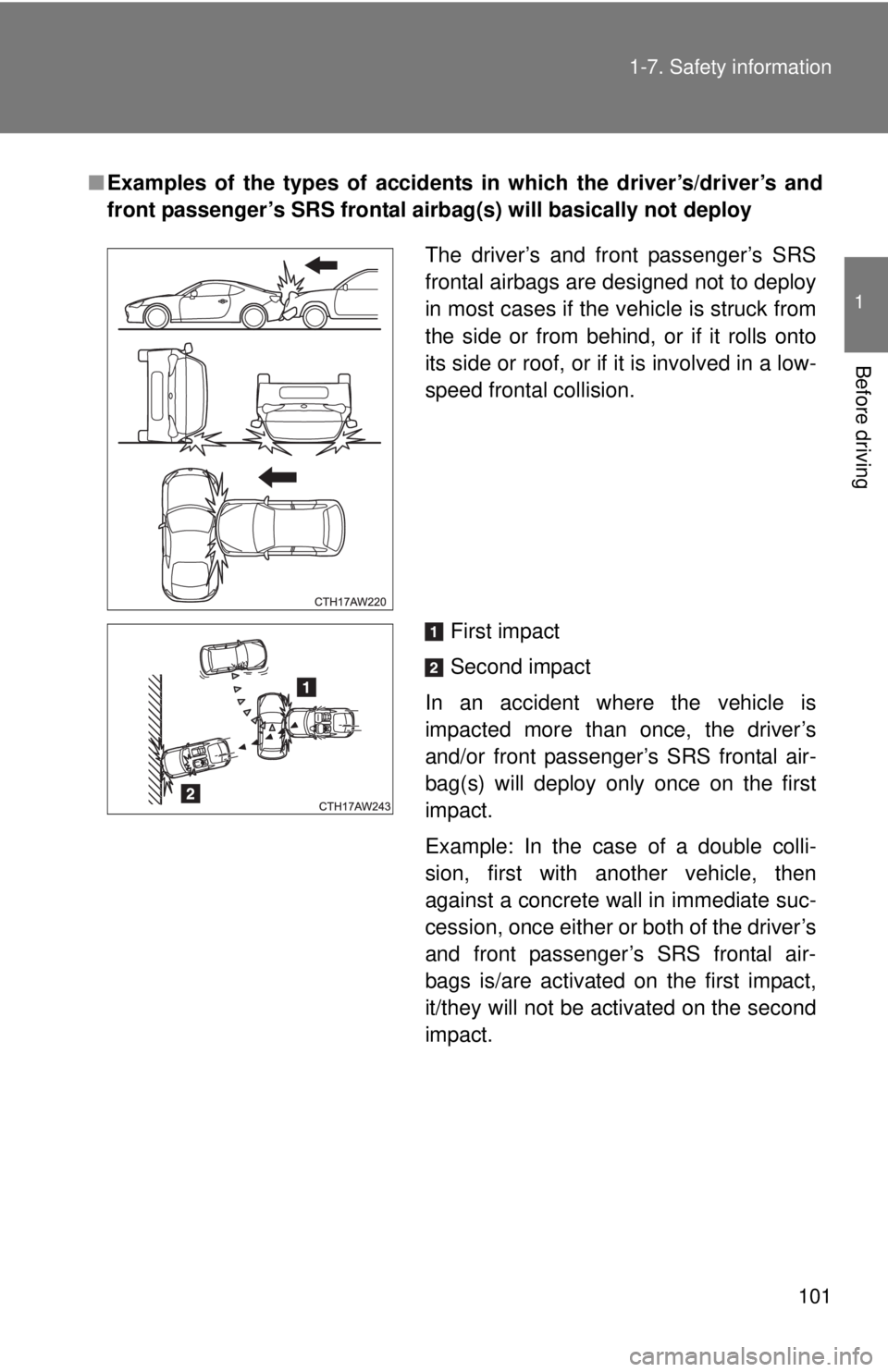
101 1-7. Safety information
1
Before driving
■Examples of the types of accidents in which the driver’s/driver’s and
front passenger’s SRS frontal airbag(s) will basically not deploy
The driver’s and front passenger’s SRS
frontal airbags are designed not to deploy
in most cases if the vehicle is struck from
the side or from behind, or if it rolls onto
its side or roof, or if it is involved in a low-
speed frontal collision.
First impact
Second impact
In an accident where the vehicle is
impacted more than once, the driver’s
and/or front passenger’s SRS frontal air-
bag(s) will deploy only once on the first
impact.
Example: In the case of a double colli-
sion, first with another vehicle, then
against a concrete wall in immediate suc-
cession, once either or both of the driver’s
and front passenger’s SRS frontal air-
bags is/are activated on the first impact,
it/they will not be activated on the second
impact.
Page 102 of 452

102 1-7. Safety information
CAUTION
■If the SRS airbags deploy
Do not touch the SRS airbag system components around the steering wheel
and dashboard with bare hands right after deployment. Doing so can cause
burns because the components can be very hot as a result of deployment.
■Child restraint precautions
NEVER INSTALL A REARWARD FACING CHILD SEAT IN THE FRONT
PASSENGER’S SEAT EVEN IF THE FRONT PASSENGER’S SRS FRON-
TAL AIRBAG IS DEACTIVATED. Be sure to install it in the REAR seat in a
correct manner. Also, it is strongly recommended that any forward facing
child seat or booster seat be installed in the REAR seat, and that even chil-
dren who have outgrown a child restraint system be also seated in the
REAR seat. This is because children sitting in the front passenger’s seat
may be killed or severely injured should the front passenger’s SRS frontal
airbag deploy. REAR seats are the safest place for children.
Page 103 of 452

103 1-7. Safety information
1
Before driving
SRS side airbag and SRS curtain shield airbag
The SRS side airbag is stored in the door side of each front seat
seatback, which bears an “SRS AIRBAG” label.
In a moderate to severe side impact collision, the SRS side airbag on
the impacted side of the vehicle deploys between the occupant and
the door panel and supplements the seat belt by reducing the impact
on the occupant’s chest and waist. The SRS side airbag operates
only for front seat occupants.
The SRS curtain shield airbag on each side of the cabin is stored in
the roof side (between the front pillar and a point over the rear seat).
An “SRS AIRBAG” mark is located at the top of each front and rear
pillar.
In a moderate to severe side impact collision, the SRS curtain shield
airbag on the impacted side of the vehicle deploys between the occu-
pant and the side window and supplements the seat belt by reducing
the impact on the occupant’s head.
Page 104 of 452

104 1-7. Safety information
■Operation
The SRS side airbag and SRS curtain shield airbag can function only when
the “ENGINE START STOP” switch is in IGNITION ON mode.
The driver’s and front passenger’s SRS side airbags and SRS curtain shield
airbags deploy independently of each other since each has its own impact
sensor. Therefore, they may not both deploy in the same accident. Also, the
SRS side airbag and SRS curtain shield airbag deploys independently of the
driver’s and front passenger’s SRS front airbags in the steering wheel and
instrument panel.
An impact sensor, which senses impact force, is located in each of the left
and right center pillars, doors and rear wheel houses. Another impact sen-
sor, which also senses impact force, is located under the center of the rear
seats.
If the impact sensor that is located under the center of the rear seats and
one of the center pillar impact sensors or door impact sensors together
sense an impact force above a predetermined level in a side collision, the
control module causes both the SRS side airbag and curtain shield airbag on
the impacted side to inflate regardless of whether the rear wheel house
impact sensor on the same side senses an impact.
If the impact sensor that is located under the center of the rear seats and
one of the rear wheel house impact sensors together sense an impact force
above a predetermined level, the control module causes only the SRS cur-
tain shield airbag on the impacted side to inflate.
After the deployment, the SRS side airbag immediately starts to deflate. The
time required from detection of an impact to deflation of an SRS side airbag
after deployment is shorter than the blink of an eye.
Page 105 of 452
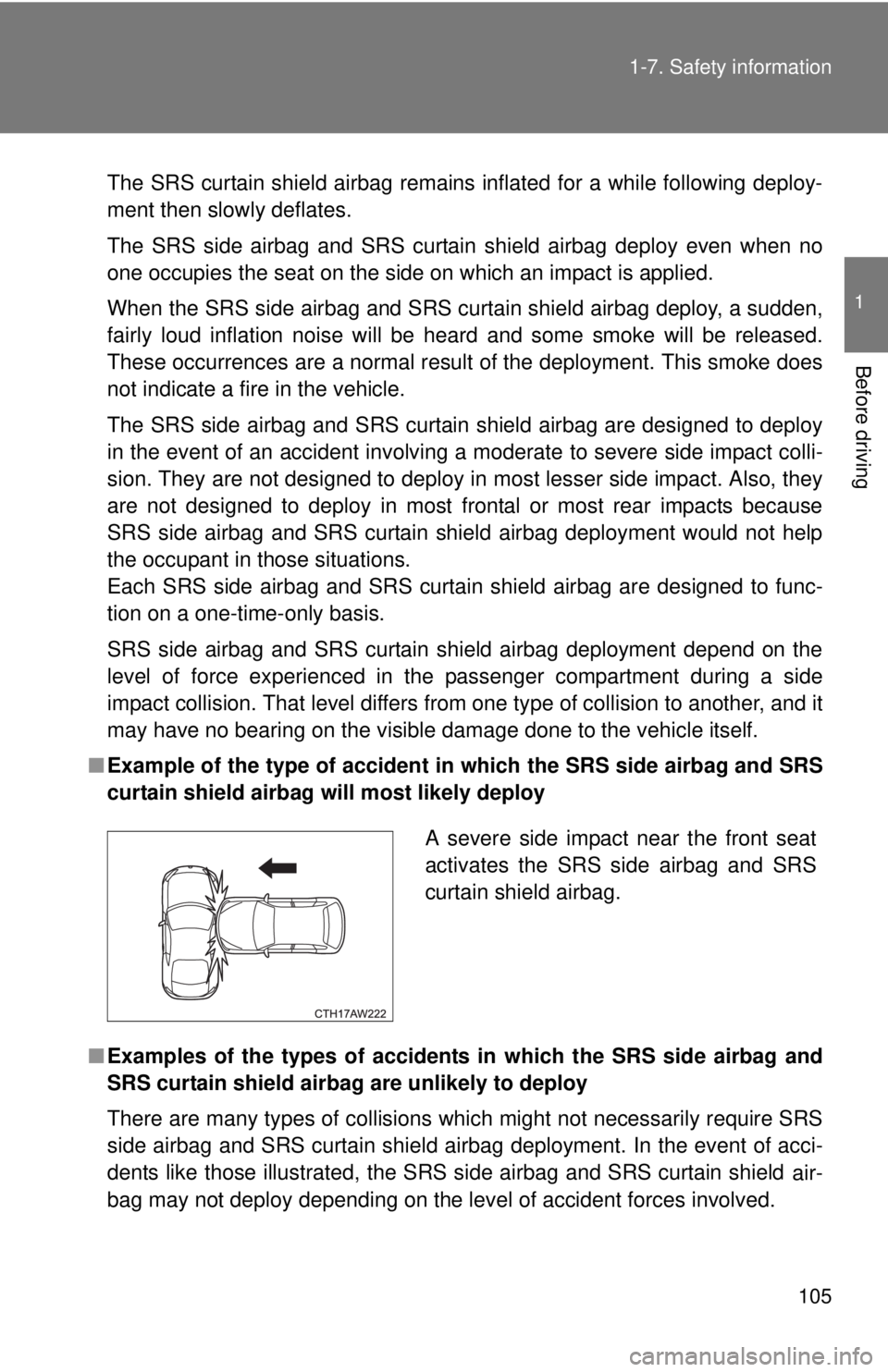
105 1-7. Safety information
1
Before driving
The SRS curtain shield airbag remains inflated for a while following deploy-
ment then slowly deflates.
The SRS side airbag and SRS curtain shield airbag deploy even when no
one occupies the seat on the side on which an impact is applied.
When the SRS side airbag and SRS curtain shield airbag deploy, a sudden,
fairly loud inflation noise will be heard and some smoke will be released.
These occurrences are a normal result of the deployment. This smoke does
not indicate a fire in the vehicle.
The SRS side airbag and SRS curtain shield airbag are designed to deploy
in the event of an accident involving a moderate to severe side impact colli-
sion. They are not designed to deploy in most lesser side impact. Also, they
are not designed to deploy in most frontal or most rear impacts because
SRS side airbag and SRS curtain shield airbag deployment would not help
the occupant in those situations.
Each SRS side airbag and SRS curtain shield airbag are designed to func-
tion on a one-time-only basis.
SRS side airbag and SRS curtain shield airbag deployment depend on the
level of force experienced in the passenger compartment during a side
impact collision. That level differs from one type of collision to another, and it
may have no bearing on the visible damage done to the vehicle itself.
■Example of the type of accident in which the SRS side airbag and SRS
curtain shield airbag will most likely deploy
■Examples of the types of accidents in which the SRS side airbag and
SRS curtain shield airbag are unlikely to deploy
There are many types of collisions which might not necessarily require SRS
side airbag and SRS curtain shield airbag deployment. In the event of acci-
dents like those illustrated, the SRS side airbag and SRS curtain shield
air-
bag may not deploy depending on the level of accident forces involved.
A severe side impact near the front seat
activates the SRS side airbag and SRS
curtain shield airbag.
Page 106 of 452
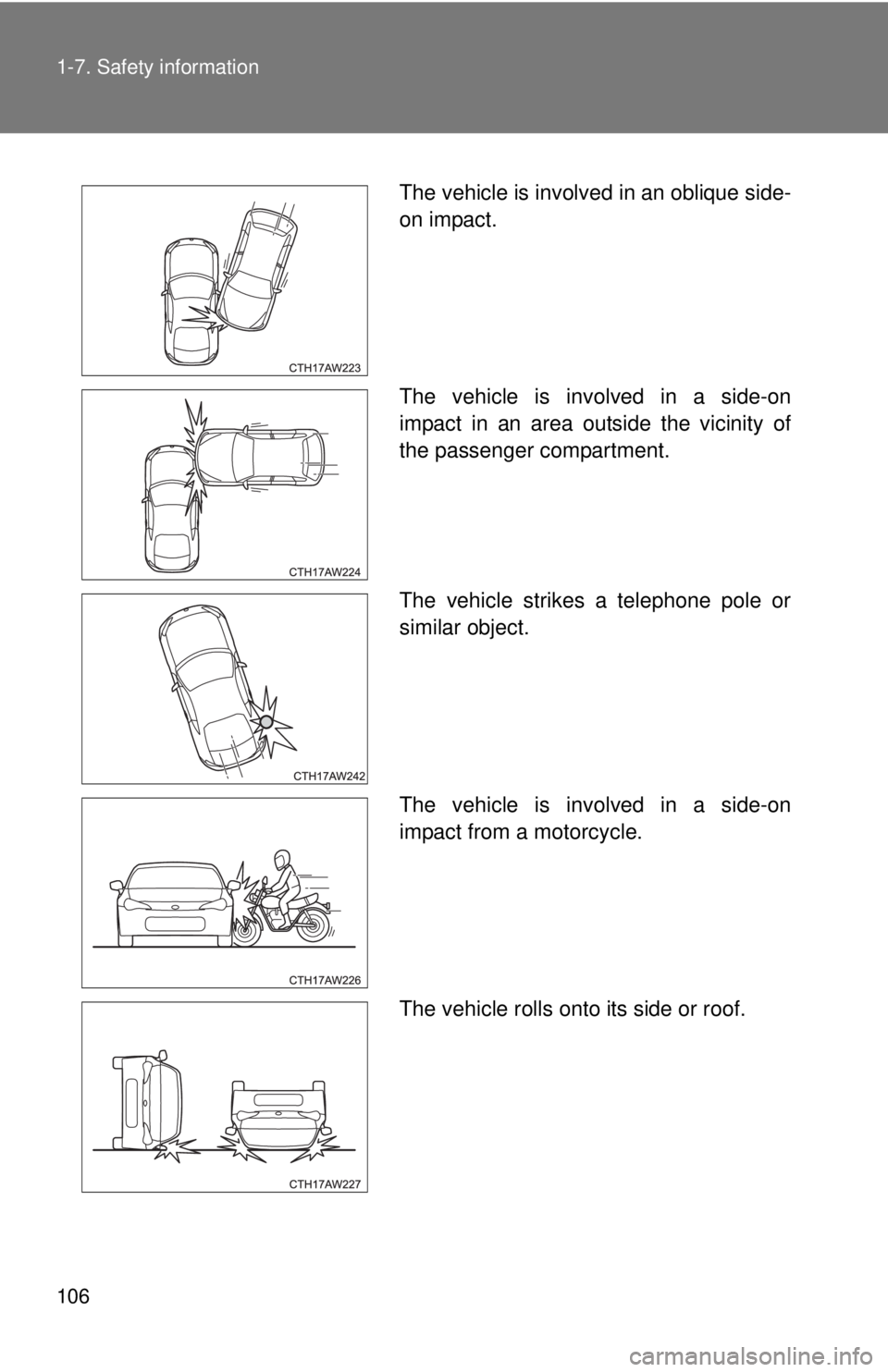
106 1-7. Safety information
The vehicle is involved in an oblique side-
on impact.
The vehicle is involved in a side-on
impact in an area outside the vicinity of
the passenger compartment.
The vehicle strikes a telephone pole or
similar object.
The vehicle is involved in a side-on
impact from a motorcycle.
The vehicle rolls onto its side or roof.
Page 107 of 452
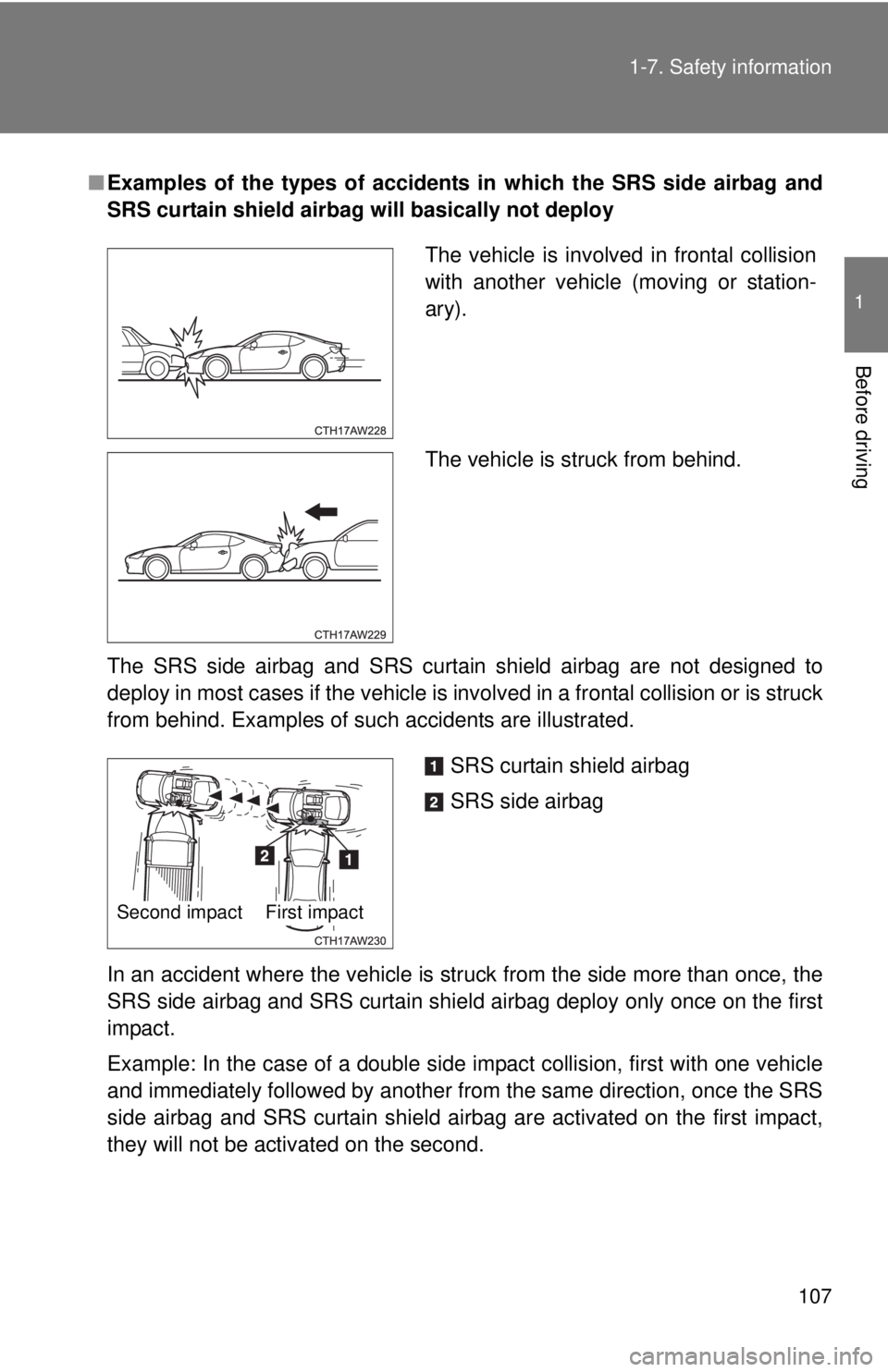
107 1-7. Safety information
1
Before driving
■Examples of the types of accidents in which the SRS side airbag and
SRS curtain shield airbag will basically not deploy
The SRS side airbag and SRS curtain shield airbag are not designed to
deploy in most cases if the vehicle is involved in a frontal collision or is struck
from behind. Examples of such accidents are illustrated.
In an accident where the vehicle is struck from the side more than once, the
SRS side airbag and SRS curtain shield airbag deploy only once on the first
impact.
Example: In the case of a double side impact collision, first with one vehicle
and immediately followed by another from the same direction, once the SRS
side airbag and SRS curtain shield airbag are activated on the first impact,
they will not be activated on the second.
The vehicle is involved in frontal collision
with another vehicle (moving or station-
ary).
The vehicle is struck from behind.
SRS curtain shield airbag
SRS side airbag
Second impact First impact
Page 108 of 452
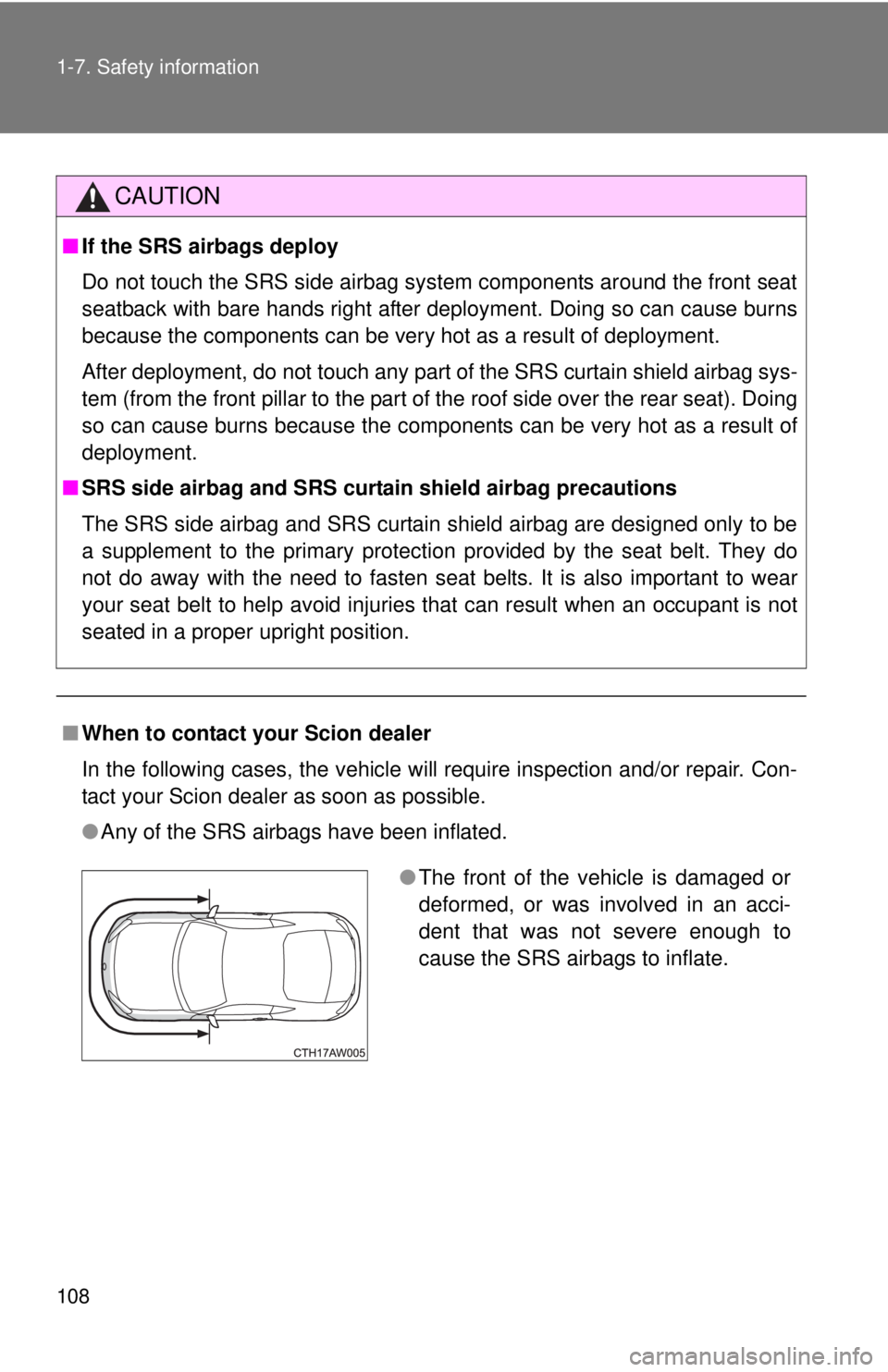
108 1-7. Safety information
CAUTION
■If the SRS airbags deploy
Do not touch the SRS side airbag system components around the front seat
seatback with bare hands right after deployment. Doing so can cause burns
because the components can be very hot as a result of deployment.
After deployment, do not touch any part of the SRS curtain shield airbag sys-
tem (from the front pillar to the part of the roof side over the rear seat). Doing
so can cause burns because the components can be very hot as a result of
deployment.
■SRS side airbag and SRS curtain shield airbag precautions
The SRS side airbag and SRS curtain shield airbag are designed only to be
a supplement to the primary protection provided by the seat belt. They do
not do away with the need to fasten seat belts. It is also important to wear
your seat belt to help avoid injuries that can result when an occupant is not
seated in a proper upright position.
■When to contact your Scion dealer
In the following cases, the vehicle will require inspection and/or repair. Con-
tact your Scion dealer as soon as possible.
●Any of the SRS airbags have been inflated.
●The front of the vehicle is damaged or
deformed, or was involved in an acci-
dent that was not severe enough to
cause the SRS airbags to inflate.
Page 109 of 452
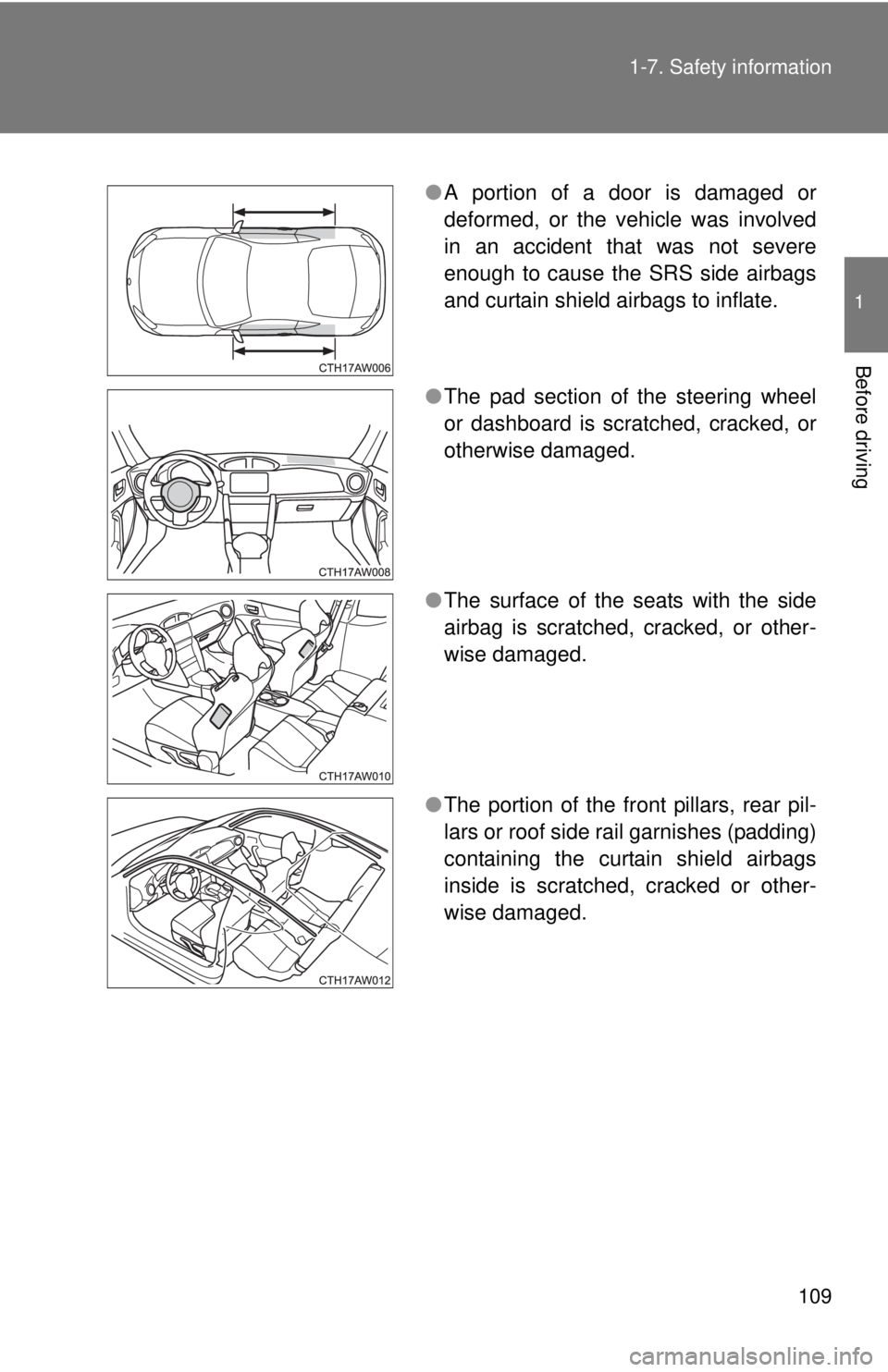
109 1-7. Safety information
1
Before driving
●A portion of a door is damaged or
deformed, or the vehicle was involved
in an accident that was not severe
enough to cause the SRS side airbags
and curtain shield airbags to inflate.
●The pad section of the steering wheel
or dashboard is scratched, cracked, or
otherwise damaged.
●The surface of the seats with the side
airbag is scratched, cracked, or other-
wise damaged.
●The portion of the front pillars, rear pil-
lars or roof side rail garnishes (padding)
containing the curtain shield airbags
inside is scratched, cracked or other-
wise damaged.
Page 110 of 452

110 1-7. Safety information
CAUTION
■SRS airbag precautions
Observe the following precautions regarding the SRS airbags.
Failure to do so may cause death or serious injury.
●The driver and all passengers in the vehicle must wear their seat belts
properly.
The SRS airbags are supplemental devices to be used with the seat belts.
●The SRS driver airbag deploys with considerable force, and can cause
death or serious injury especially if the driver is very close to the airbag.
The National Highway Traffic Safety Administration (“NHTSA”) advises:
Since the risk zone for the driver’s airbag is the first 2 - 3 in. (50 - 75 mm)
of inflation, placing yourself 10 in. (250 mm) from your driver airbag pro-
vides you with a clear margin of safety. This distance is measured from the
center of the steering wheel to your breastbone. If you sit less than 10 in.
(250 mm) away now, you can change your driving position in several
ways:
• Move your seat to the rear as far as you can while still reaching the
pedals comfortably.
• Slightly recline the back of the seat. Although vehicle designs vary,
many drivers can achieve the 10 in. (250 mm) distance, even with the
driver seat all the way forward, simply by reclining the back of the seat
somewhat. If reclining the back of your seat makes it hard to see the
road, raise yourself by using a firm, non-slippery cushion, or raise the
seat if your vehicle has that feature.
• If your steering wheel is adjustable, tilt it downward. This points the air-
bag toward your chest instead of your head and neck.
The seat should be adjusted as recommended by NHTSA above, while
still maintaining control of the foot pedals, steering wheel, and your view of
the instrument panel controls.